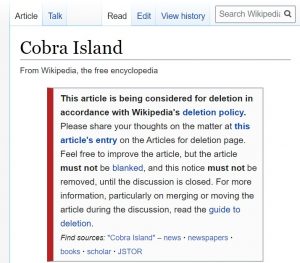Your Wikipedia Article Is Up For Deletion. What Do You Do?
Your company or your CEO has a Wikipedia article. Suddenly, you notice a tag on the top of the article screaming that the article is about to be deleted. What happened? Why is the article being deleted? Will it actually be deleted? And what, if anything, can you do about it?
Why Would Your Article Be Deleted?
Before we discuss how the deletion process works, it makes sense to explain briefly why your article might be considered for deletion. There are straightforward reasons for this, including copyright violations, vandalism, a lack of sources, and obvious advertising.
There are more nuanced reasons as well, the most relevant of which is the question of notability. Not every topic belongs on Wikipedia, and Wikipedia has specific guidelines about what makes a person or company notable. For a topic to be notable, it needs to have significant coverage in reliable sources that are independent of the subject. There are other specific criteria as well, all of which are explained on Wikipedia.
The Deletion Process
If you use WikiAlerts, or you carefully monitor pages that interest you in another way, you will be alerted as soon as someone tags your article for deletion.
Wikipedia editors may go about the deletion process in one of three ways:
- Speedy deletion: A speedy deletion is proposed by an editor when they believe that the article so clearly does not belong on Wikipedia that a full discussion is unnecessary. There is a long list of criteria that would warrant a speedy deletion. The most relevant for our purposes include: copyright infringement, unambiguous advertising or promotion, and the recreation of a page that was already deleted through a deletion discussion. The person nominating it for speedy deletion will specify the reason in the deletion summary and can immediately delete the page. They don’t need to wait for any discussion or agreement. Boom, it’s just gone.
- Proposed Deletion: If an article doesn’t meet the very narrow criteria for speedy deletion, but an editor feels that it should be deleted and that it won’t be controversial to do so, they can propose it for deletion. This is a gentle deletion tag, because any editor can remove the tag if they have justification for saving the page. If the tag remains for seven days, the page can be deleted.
- Articles for Deletion (AfD): When an editor feels that deletion is appropriate, but that a discussion should take place about the topic, they will engage in the deletion discussion process. The editor will nominate it for deletion with the AfD tag and create a new page where the discussion will take place. Other users who monitor AfD discussions will be notified that this conversation is taking place. Typically, a deletion discussion lasts for seven full days and consensus is NOT based on a tally of votes, but on consideration of reasonable, policy-based arguments.
At decision time, a Wikipedia administrator who has not participated in the conversation will access the arguments and decide that consensus was reached to delete the page, that consensus was reached to keep the page, or that consensus wasn’t clear. If it wasn’t clear, the page may be relisted to generate more conversation, or a decision of No Consensus can be decided and the article kept.
So Now: What Can You Do?
The preferred way to deal with the issue of deletion is to avoid it in the first place. As we all know, an ounce of prevention is worth a pound of cure. It’s always best to prevent this situation from occurring by making sure there are many good media sources about your brand. Before a Wikipedia article gets written about your company or CEO, make sure that there is extensive, impartial online coverage.
But what if you have not avoided it, and now you stand at the brink of deletion?
- DO NOT create an editor and jump into the conversation if you have a conflict of interest. Wikipedia has very strict guidelines about getting involved in creating, editing, or defending any articles that you have any connection to without declaring that connection.
- You DO have the option of creating a COI editor and going onto the talk page to suggest additional references or content that might help other editors to add to the Wikipedia page and the conversation.
- In addition, you can actually join the AfD (Articles for Deletion) conversation as a COI editor and make a strong argument for the inclusion of your piece (as a declared COI editor), but you will not be allowed to vote on behalf of your article.
It Ain’t Over ‘Till It’s Over
If the article ends up being deleted, don’t despair. It’s possible that sometime in the future the company or individual will become notable enough for inclusion in Wikipedia. In these situations, the focus should be on strengthening your website, Facebook, LinkedIn and other online properties to tell your story the best way you can even without Wikipedia. If you believe, however, that you really are Wiki-worthy now, then you should focus on getting more reliable, third-party, independent coverage online. That’s the way toward proving your notability, which is the high road to Wikipedia.

